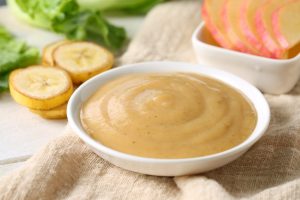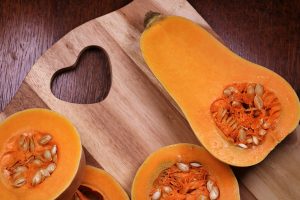 Making your own baby food can provide a less expensive, environmentally-friendly alternative to store-bought baby food that is just as (if not more) nutritious. Preparing homemade food for your baby also teaches them to enjoy the kinds of foods that you serve to the rest of your family. And while leaving behind the convenience of store-bought baby food may seem daunting at first, making your own is actually quite simple.
Making your own baby food can provide a less expensive, environmentally-friendly alternative to store-bought baby food that is just as (if not more) nutritious. Preparing homemade food for your baby also teaches them to enjoy the kinds of foods that you serve to the rest of your family. And while leaving behind the convenience of store-bought baby food may seem daunting at first, making your own is actually quite simple.
When is your baby ready?
For the first few months of their lives, babies should be fed breast milk or formula only. However, once a baby is about six months old, they begin to reach the following developmental milestones:
- Sitting without being supported
- Holding their neck steady
- Opening their mouth when offered food
- Using their tongue to move food into their mouth instead of pushing it out
If your baby is about six months old and has reached these milestones, try supplementing breast milk or formula with baby food.
General Guidelines
Begin by offering one single ingredient food at a time, for example apples not apple pie. Feed your baby this food for several days in a row, and watch for signs of a food allergy. Only after you have eliminated possible food allergies should you start combining foods. Feed your baby slowly. Encourage them to try new foods, but never force them to eat anything.
Foods to Use
Use high-quality fresh, frozen, or canned vegetables, fruits, and meats. If you choose to use commercially processed canned or frozen foods, read the ingredient label to make sure the product doesn’t contain added salt, seasonings, sugar, fats, or other additives.
Foods that are commonly used to make baby food include:
- Bananas
- Apples

- Pears and peaches
- Potatoes
- Sweet potatoes
- Winter squash
- Peas
- Asparagus
- Green beans
- Egg yolks
Foods to Avoid
Nitrates in some vegetables can prevent your baby from absorbing enough oxygen in the bloodstream and cause Blue Baby Syndrome. These vegetables include but are not limited to beets, broccoli, cabbage, carrots, celery, collard greens, lettuce, spinach, and turnips. Babies under six months old should avoid these vegetables completely. Babies 6-12 months old should be limited to 1-2 tablespoons per feeding.
Other foods to avoid during the first year include:
- Seafood
- Citrus fruits or juices
- Home-canned foods
- Foods containing honey
- Cow’s milk
Baby Food Preparation
- Start with a clean kitchen and clean hands.
- Thoroughly rinse fresh produce, and remove all seeds or pits. Remove all bones, fat, and gristle from meat or poultry.
- Cook fruits and vegetables until tender. Cook all meat or poultry to a safe temperature.
- Steaming and boiling conserve the most nutrients, but food can also be baked, broiled, or poached. Vegetables can even be microwaved, but no food should be fried.
- Do NOT add salt, seasonings, sugar, fat, or other additives until your baby is at least one year old.
- Some foods, like ripe bananas, don’t need to be cooked and can simply be mashed with a fork.
- Puree until you achieve a liquid-like, smooth texture.
- Use a fork, potato masher, blender, strainer, food mill, or baby food grinder.
- Add formula, breast milk, fruit juice, or water until you reach the right consistency.
- As your baby grows, gradually progress from pureeing to mashing, then dicing.
Serving
Homemade baby food can be served cold, at room temperature, or slightly warmed. Before serving, stir and test the food to ensure it’s not too hot. Food should only be reheated once. Food that has been thawed should not be refrozen.
Storing
Freshly made baby food that isn’t consumed immediately should be refrigerated or frozen within two hours. Use refrigerated baby food containing meats within 1 day or fruits and vegetables within 3 days. Use frozen baby foods containing meats within 2 months or fruits and vegetables within 8 months.
To freeze:
- Pour food into sections of a clean ice cube tray, or drop small (1-2 tablespoon) servings onto a clean cookie sheet.
- Cover, and put in the freezer.
- When frozen solid, transfer to a freezer container or bag.
- Label with the type of food and the date, and store in the freezer.
Thawing:
- Thaw food in the refrigerator, under cold running water, or by reheating.
- Never thaw on the counter.
Recipes and More Information
Colorado State University: https://extension.colostate.edu/topic-areas/nutrition-food-safety-health/introducing-solid-foods-to-infants-9-358/
Clemson University Extension: https://hgic.clemson.edu/factsheet/making-your-own-baby-food/
The University of Maine Extension: https://extension.umaine.edu/publications/4309e/
Penn State Extension: https://extension.psu.edu/make-your-own-baby-food-and-save-money


This is great and we have needed more information on baby food.
Great article! I have a 4 month old boy that will be starting to eat solid foods very soon. This information has pointed me in the right direction, and I will be bookmarking it for the additional resources you’ve included!